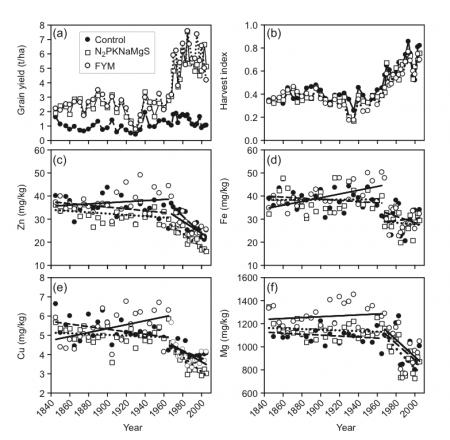![]() Following up on our recent post drawing attention to the overall decline in micronutrients in fruit and veg, here’s a 2008 paper dealing specifically with wheat. Ming-Sheng Fang and colleagues looked at levels of minerals in grain harvested from one of the longest-running agricultural experiments in the world, the Broadbalk Wheat Experiment. Not just grain, but soil too. And not just historical records — since 1843! — but a direct experiment growing an old variety alongside a modern one.
Following up on our recent post drawing attention to the overall decline in micronutrients in fruit and veg, here’s a 2008 paper dealing specifically with wheat. Ming-Sheng Fang and colleagues looked at levels of minerals in grain harvested from one of the longest-running agricultural experiments in the world, the Broadbalk Wheat Experiment. Not just grain, but soil too. And not just historical records — since 1843! — but a direct experiment growing an old variety alongside a modern one.
The paper 1 is honestly a model of clarity; anyone can read and understand it. And the conclusion is pretty straightforward too.
The concentrations of zinc, iron, copper and magnesium remained stable between 1845 and the mid 1960s, but since then have decreased significantly, which coincided with the introduction of semi-dwarf, high-yielding cultivars. In comparison, the concentrations in soil have either increased or remained stable. Similarly decreasing trends were observed in different treatments receiving no fertilizers, inorganic fertilizers or organic manure. Multiple regression analysis showed that both increasing yield and harvest index 2 were highly significant factors that explained the downward trend in grain mineral concentration.
Here’s a picture.

And here’s a final, circumspect, conclusion.
Results from the present study suggest that the Green Revolution has unintentionally contributed to decreased mineral density in wheat grain, at least in the Broadbalk Experiment. The study of Garvin et al. [9] suggests that this may also be the case for US wheat.
There are a few other papers showing very similar effects, not all of them straightforward. The general conclusion — that environmental and genetic dilution effects have reduced the concentration of many micronutrients in modern varieties — surely stands.
- Fan, M., Zhao, F., Fairweather-Tait, S., Poulton, P., Dunham, S., & McGrath, S. (2008). Evidence of decreasing mineral density in wheat grain over the last 160 years Journal of Trace Elements in Medicine and Biology, 22 (4), 315-324 DOI: 10.1016/j.jtemb.2008.07.002
- Harvest Index is the ratio of the grain weight to the weight of the whole plant, and is higher in dwarf varieties.
Does the wheat grain study apply to sprouted bread? I just started buying Ezekiel bread because I heard it is healthier. Does this fall into the study?
The results apply to all products made from wheat.
Its not enough that the heritage wheat contains higher mineral content but also that to get the value of this milling extraction should be high and preferably stone ground since modern roller milled industrial white flour typically excludes the aleurone and germ portions of the grain where mineral content is concentrated whether in modern or “old” wheat. In addition in typical modern baking the dough will not have had enough time for phytase activity to cleave phytate content freeing minerals bound (chelated) by phytate – typically best performed by a sourdough process or use of sprouted grain.